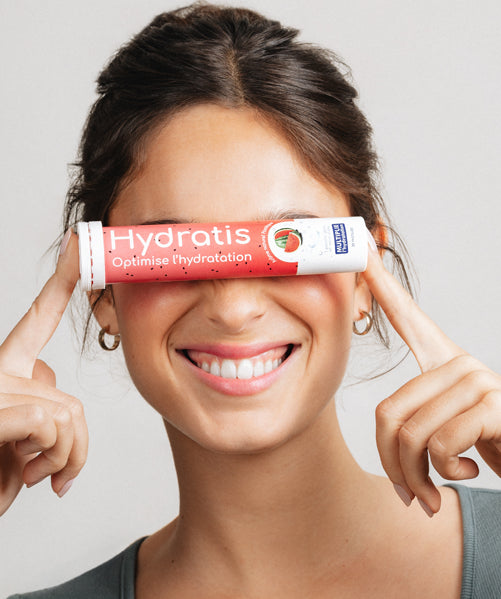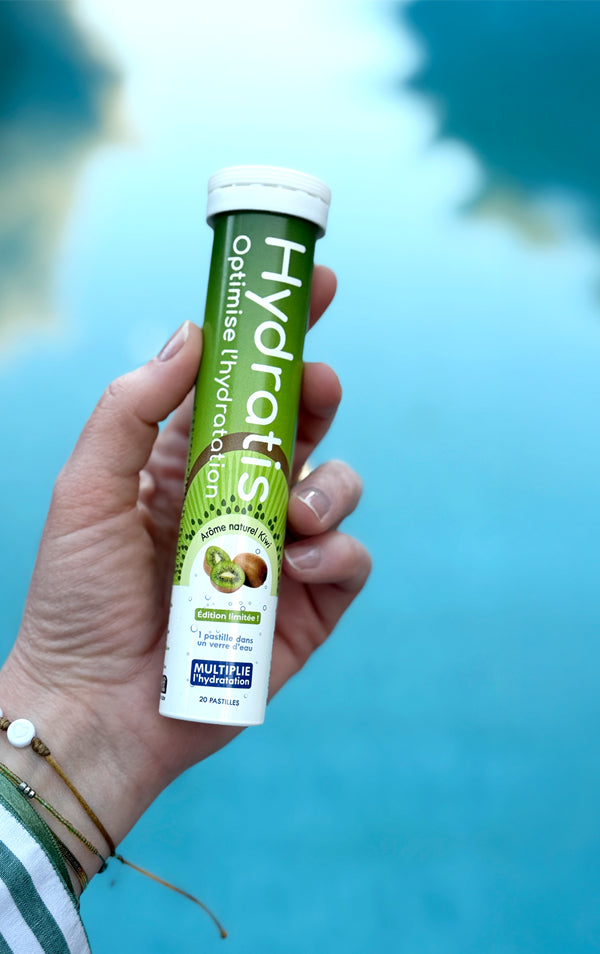Menopause is a natural stage in a woman's life, but it is accompanied by numerous hormonal and physical changes. Among the often underestimated effects, dehydration plays a central role.
Indeed, many menopausal women experience increased thirst, dry skin , or persistent fatigue, without always understanding that these symptoms their body presents reflect a lack of hydration .
This article provides practical advice to better understand the links between menopause and hydration , and to recognize the symptoms. dehydration , and discover how to adapt your daily routine to preserve your health and well-being.
Why does menopause increase the risk of dehydration?
Menopause triggers a series of hormonal and physiological changes that disrupt the fluid balance in the body . Several mechanisms explain these disturbances.
Hot flashes and night sweats that increase water loss
Elise Furet, a gynecologist and specialist in robotic gynecological surgery, states in this article that " the most frequently observed symptoms during menopause are hot flashes . They are characterized by a sudden sensation of intense heat that spreads throughout the upper body, often accompanied by skin redness and excessive sweating."
They also lead to significant loss of water and minerals, especially if they occur several times a day.
These episodes of intense sweating have a direct effect on the nervous and muscular systems. They can cause a deficiency in electrolytes (particularly sodium, potassium, and magnesium), which are essential for the proper functioning of the body .
These mechanisms, combined with age and the decline of certain hormones, reduce the body's ability to maintain optimal hydration . This directly results in a disruption of body temperature and sleep.
Regular water intake helps to compensate for these losses and limit the risk of dehydration .
Decrease in estrogen levels and its impact on fluid regulation
At menopause , estrogen production gradually declines. These hormones play a crucial role in regulating the body 's fluid balance . They promote the proper distribution of fluids in tissues and contribute to maintaining skin elasticity .
When their levels decrease, the body loses some of its ability to retain water , leading to faster dehydration . Furthermore, the sensation of thirst tends to diminish with age, making maintaining hydration levels even more important.
Natural skin aging and decreased skin elasticity
The natural aging of the skin , combined with the drop in estrogen, reduces the production of collagen and hyaluronic acid . These two components are naturally present in the body and ensure the firmness and hydration of the skin .
This reduction makes the epidermis thinner, less supple, and more prone to dryness. In other words, even if you drink enough, water retention in cells is less efficient, hence the need for both internal and external hydration .
What are the symptoms of dehydration during menopause?

" Paying attention to hydration is essential at any age, but even more so during menopause , when the body becomes more sensitive and symptoms related to dehydration become more frequent," explains nutritionist Antonia de Gier in a feature on menopause.
Dehydration during menopause can manifest through a variety of visible and felt symptoms throughout the body. Identifying these symptoms early allows for effective solutions .
Persistent fatigue and decreased energy
Dehydration affects metabolism and the transport of nutrients in the body. You may experience fatigue. unusual , even after a good night's sleep.
This energy loss is explained by a decrease in volume blood , which limits the supply of oxygen to the muscles and brain.
Dryness of the skin, eyes and mucous membranes
Tight skin, chapped lips, or dryness Vaginal symptoms are clear signs of dehydration .
The mucous membranes , which play a protective role, become more fragile and prone to irritation. This can impact quality of life, particularly in the intimate sphere.
Headaches, dizziness, dry mouth
When the body lacks water, blood pressure tends to drop, which can cause dizziness or headaches. of head .
The sensation of dry mouth and decreased salivation are also common, with direct effects on health. oral and function physical activity in general.
Concentration and mood disorders
The brain is particularly sensitive has there Dehydration . Even moderate water loss (1 to 2% of body weight) can impair function . Cognitive : difficulty concentrating, irritability, low mood, stress, etc.
These effects can be compounded by hormonal fluctuations, amplifying the disorders. of mood swings typical of menopause .
The consequences of dehydration on health and skin
The consequences of insufficient hydration are not limited to excessive sweating or temporary fatigue. It also impacts cardiovascular health, sleep, the urinary system, etc.
Impact on cardiovascular health
The decrease in volume Blood flow linked to dehydration can exacerbate the disorders circulatory . The heart must exert effort additional effort to pump blood, which increases fatigue and can worsen certain cardiovascular conditions.
However, at menopause , the risk of diseases Heart rate is already higher due to the drop in estrogen. protectors .
Increased risk of urinary tract infections
Hydration Insufficient urination reduces the frequency of urination . urine and promotes proliferation bacterial in the pathways urinary .
This explains why urinary tract infections are more common in menopausal women. Drinking water regularly helps to naturally cleanse the kidneys and bladder.
Accelerated skin aging (wrinkles, loss of radiance)
Dehydrated skin loses its suppleness and radiance. Wrinkles become more visible, especially in delicate areas such as around the eyes or mouth.
Lack of hydration also weakens the skin barrier, making the skin more sensitive to external aggressions (pollution, UV rays, wind).
Worsening of fatigue and sleep disturbances
Dehydration can disrupt the rhythm circadian rhythm and exacerbate insomnia, which is already common during menopause.
Furthermore, the alarm clocks Nighttime sweating can worsen water loss, creating a vicious cycle a vicious cycle of lack of sleep and chronic fatigue.
What drinks should I choose during menopause to stay well hydrated?
To compensate for dehydration related to menopause , the choice of drinks plays a crucial role.
Water: the essential basis of hydration
Water remains the most effective drink to compensate for losses hydration . It is recommended to drink regularly throughout the day, without waiting until you are thirsty.
For women, the recommended daily intake is 1.6 liters, adjusted according to your activity level, the temperature, and the frequency of hot flashes. For personalized advice, feel free to take our hydration quiz on our website.
Sugar-free herbal teas and infusions
Herbal teas made from plants like chamomile, verbena, or peppermint are excellent alternatives to water. They soothe, aid digestion, and contribute to hydration. However, avoid overly diuretic infusions (such as excessive amounts of green tea).
Mineral-rich waters (magnesium, calcium) to compensate for losses
Certain mineral waters , rich in magnesium or calcium , can help regulate cramps , fatigue , or irritability associated with menopause . These minerals contribute to balance. nervous and muscular and support density bone .
Drinks containing electrolytes during periods of high heat or physical activity
During physical exertion or during periods In summer , drinks containing electrolytes are useful to avoid mineral deficiencies.
What drinks should be avoided during menopause?

While some drinks promote hydration and well-being, others can, on the contrary, accentuate dehydration and worsen the symptoms of menopause.
Excessive coffee and energy drinks
Coffee, when consumed in excess, has a diuretic effect that promotes the loss of water and minerals. Two cups a day are more than enough. Beyond this amount, it risks worsening dehydration and palpitations.
Energy drinks, often high in caffeine and sugar, should be avoided for the same reasons.
Alcohol worsens dehydration and hot flashes
Alcohol increases urine production, dilates blood vessels , and intensifies hot flashes . Even moderate consumption can cause flushing and disrupt sleep. If you drink alcohol occasionally, always make sure to compensate by drinking plenty of fluids .
Sugary sodas and industrial drinks
High in sugar and additives, sodas disrupt blood sugar levels and contribute to water retention. They also promote weight gain, a common concern during menopause.
To combine pleasure and hydration , opt instead for homemade infused waters with lemon, mint or cucumber.
Practical tips to prevent dehydration
According to Dr. Louise Newson, a hormonal health expert and bestselling author, the following tips will help you support your hydration levels during menopause.
Drink regularly, even if you're not thirsty.
Experts recommend drinking water throughout the day , taking small sips . During menopause, the sensation of thirst diminishes. It is therefore best to establish a routine : a glass of water upon waking, one before each meal, and then a few sips every hour.
Focus on hydration through food
Some foods, especially fruits and vegetables (cucumber, watermelon, orange, courgette, etc.) have a high water content and naturally contribute to hydration.
Homemade soups or smoothies are also excellent options, especially when you have trouble drinking enough water.
External care and hydration supplements
Use moisturizing solutions and creams rich in hyaluronic acid and ceramides as external care.
You can also use hydration tablets , which are useful in hot weather or during exertion, to compensate for electrolyte loss.
How to improve skin hydration during menopause?
Providing external care for your skin is a very useful step to maintain good hydration during menopause .
Suitable moisturizing care
Formulas containing hyaluronic acid plump the skin and retain moisture, while ceramides strengthen the skin barrier . Apply them to slightly damp skin to maximize their effectiveness.
Sun protection and a balanced diet
Daily sun protection is essential to prevent dryness and premature skin aging . Combine it with a diet rich in omega-3 fatty acids (oily fish, flax seeds, walnuts) to boost the skin's natural hydration .
Conclusion: Hydration, an essential reflex during menopause
Hydration is one of the cornerstones of well-being during menopause. Drinking regularly, choosing natural beverages, and nourishing your skin are simple yet essential steps.
By adopting these habits, you help to preserve your energy , your health and the beauty of your skin, while getting through this transition period with serenity.
Frequently asked questions about dehydration during menopause
How can I tell if I am dehydrated during menopause?
Common signs include a dry mouth, dull skin, unusual fatigue, headaches, and dizziness.
What are the best drinks to stay hydrated during menopause?
Water remains the number one choice, supplemented by sugar-free herbal teas and mineral waters rich in calcium and magnesium.
What drinks should be avoided during menopause?
Excessive coffee, alcohol and sugary sodas, as they promote dehydration and worsen certain symptoms such as hot flashes.
Can fatigue during menopause be linked to dehydration?
Yes, insufficient fluid intake increases fatigue, sleep disturbances, and difficulty concentrating.
How can I effectively hydrate my skin during menopause?
By combining good internal hydration (water, food) with suitable cosmetic care such as moisturizing creams and hyaluronic acid serums.
Bibliography
Stachenfeld, N.S. (2014). Hormonal Changes During Menopause and the Impact on Fluid Regulation. Reproductive Sciences , 21 (5), 555-561. https://doi.org/10.1177/1933719113518992
Hooton, T.M., Vecchio, M., Iroz, A., Tack, I., Dornic, Q., Seksek, I., & Lotan, Y. (2018). Effect of Increased Daily Water Intake in Premenopausal Women With Recurrent Urinary Tract Infections. JAMA Internal Medicine , 178 (11), 1509. https://doi.org/10.1001/jamainternmed.2018.4204
Norris, T. (2023, July 31). Is Dizziness a Symptom of Menopause? Healthline. https://www.healthline.com/health/menopause/menopause-dizziness
Yetter, M., & Jantz, K. (2023, January 15). Menopause . Examine.com. https://examine.com/conditions/menopause/?srsltid=AfmBOorI9pumYkaCR5mOENtUbxm4eTSsrOkdVUySjDjXMR8m1ia-zcM-
Erdélyi, A., Pálfi, E., Tűű, L., Nas, K., Szűcs, Z., Török, M., Jakab, A., & Várbíró, S. (2023). The Importance of Nutrition in Menopause and Perimenopause—A Review. Nutrients , 16 (1), 27. https://doi.org/10.3390/nu16010027






